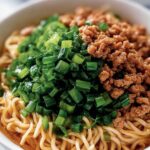Description
Dan Dan Noodles is a classic spicy Sichuan dish featuring tender Chinese wheat noodles in a bold, savory sauce made from ground pork, spicy bean paste, peanut butter, and a mix of flavorful seasonings, garnished with green onions, crushed peanuts, and chili oil for an authentic taste experience.
Ingredients
Scale
Noodles
- 8 oz. fresh or dried Chinese wheat noodles
Meat and Sauce
- 1 tablespoon vegetable oil
- 1/2 pound ground pork (or chicken, if preferred)
- 2 cloves garlic, minced
- 1 tablespoon ginger, minced
- 2 tablespoons doubanjiang (spicy bean paste)
- 1 tablespoon soy sauce
- 1 tablespoon rice vinegar
- 1 tablespoon sesame oil
- 1 tablespoon peanut butter (or tahini for a different flavor)
- 1 cup chicken broth (or water)
Garnishes
- 2 green onions, chopped
- 1/4 cup roasted peanuts, crushed
- 1 tablespoon chili oil (optional, for extra heat)
- Fresh cilantro (for garnish, optional)
Instructions
- Boil Noodles: Boil a large pot of water with a pinch of salt to prepare for cooking the noodles.
- Cook Noodles: Add the Chinese wheat noodles to the boiling water. Fresh noodles will cook in 2-3 minutes, while dried noodles may need 5-7 minutes.
- Stir Noodles: Stir occasionally to prevent the noodles from sticking together as they cook.
- Drain and Rinse: Drain the noodles and rinse under cold water to stop the cooking process. Set aside for later use.
- Heat Oil: Heat vegetable oil in a large skillet or wok over medium heat to prepare for cooking the meat and sauce.
- Cook Meat: Add ground pork or chicken and sauté until browned, about 5-7 minutes, breaking it up as it cooks.
- Add Aromatics: Stir in minced garlic and ginger, cooking for about 1 minute until fragrant to enhance the flavor base.
- Add Doubanjiang: Mix in the spicy bean paste thoroughly with the meat to infuse heat and depth in the sauce.
- Add Seasonings: Pour in soy sauce, rice vinegar, and sesame oil, stirring continuously for about 2 minutes to blend the flavors.
- Add Peanut Butter: Incorporate peanut butter or tahini into the mixture, stirring until the sauce becomes creamy and well combined.
- Simmer Sauce: Gradually add chicken broth or water while stirring. Let the sauce simmer for 3-5 minutes to thicken and develop flavor.
- Combine Noodles and Sauce: Add the cooked noodles to the skillet with the sauce, tossing to coat the noodles evenly.
- Adjust Sauce Consistency: Add more broth or water if the sauce is too thick, ensuring the noodles are well coated.
- Heat Through: Cook the noodles with sauce for an additional 2-3 minutes to warm everything thoroughly.
- Serve: Remove the skillet from heat and transfer the noodles to serving bowls.
- Garnish: Top with chopped green onions, crushed roasted peanuts, and optional chili oil for extra spice.
- Add Cilantro: Optionally sprinkle fresh cilantro to add a fresh herbal aroma and flavor.
- Enjoy: Serve immediately for the best flavor and texture.
Notes
- Fresh noodles cook faster than dried noodles, so adjust cooking time accordingly.
- Doubanjiang is a key ingredient for authentic flavor but can be adjusted for heat preference.
- Peanut butter adds creaminess and a nutty flavor; tahini is a good alternative for a different but complementary taste.
- Chili oil is optional and can be added based on desired spice level.
- Rinsing noodles after boiling prevents sticking and stops overcooking.
- Use a wok or large skillet for best results because it allows even cooking and easy stirring.

